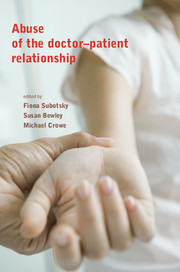Book contents
- Frontmatter
- Contents
- List of figures, tables and boxes
- List of contributors
- Foreword
- Introduction: mapping the territory
- 1 The ethical importance of boundaries to intimacy
- 2 The patient's perspective: impact and treatment
- 3 Teaching ethics and ethical behaviour to medical students
- 4 With the benefit of hindsight: lessons from history
- 5 The prevalence of boundary violations between mental health professionals and their clients
- 6 Psychiatry: responding to the Kerr/Haslam Inquiry
- 7 The general practitioner and abuse in primary care
- 8 Boundaries and boundary violations in psychotherapy
- 9 Sexual therapies: ethical guidelines, vulnerabilities and boundaries
- 10 Obstetrics and gynaecology: a special case?
- 11 Nurses as abusers: a career perspective
- 12 Medical management: governance and sexual boundary issues
- 13 Dealing with offending doctors: sanctions and remediation
- 14 Defending doctors: the protection society's experience
- 15 Regulation and its capacity to minimise abuse by professionals
- 16 The role of the General Medical Council
- Appendix 1 Extract from Vulnerable Patients, Safe Doctors
- Appendix 2 Codes of ethics of psychiatric associations in other countries
- Appendix 3 Guidance from the Council for Healthcare Regulatory Excellence
- Appendix 4 Examples of determinations by the General Medical Council's Fitness to Practise panels
- Appendix 5 Website resources and information
- Index
- Plate section
4 - With the benefit of hindsight: lessons from history
Published online by Cambridge University Press: 02 January 2018
- Frontmatter
- Contents
- List of figures, tables and boxes
- List of contributors
- Foreword
- Introduction: mapping the territory
- 1 The ethical importance of boundaries to intimacy
- 2 The patient's perspective: impact and treatment
- 3 Teaching ethics and ethical behaviour to medical students
- 4 With the benefit of hindsight: lessons from history
- 5 The prevalence of boundary violations between mental health professionals and their clients
- 6 Psychiatry: responding to the Kerr/Haslam Inquiry
- 7 The general practitioner and abuse in primary care
- 8 Boundaries and boundary violations in psychotherapy
- 9 Sexual therapies: ethical guidelines, vulnerabilities and boundaries
- 10 Obstetrics and gynaecology: a special case?
- 11 Nurses as abusers: a career perspective
- 12 Medical management: governance and sexual boundary issues
- 13 Dealing with offending doctors: sanctions and remediation
- 14 Defending doctors: the protection society's experience
- 15 Regulation and its capacity to minimise abuse by professionals
- 16 The role of the General Medical Council
- Appendix 1 Extract from Vulnerable Patients, Safe Doctors
- Appendix 2 Codes of ethics of psychiatric associations in other countries
- Appendix 3 Guidance from the Council for Healthcare Regulatory Excellence
- Appendix 4 Examples of determinations by the General Medical Council's Fitness to Practise panels
- Appendix 5 Website resources and information
- Index
- Plate section
Summary
Ancient Greece
The so-called Hippocratic oath of classical times, whether or not it was in widespread use, started with an invocation to the gods of medicine: Apollo the Olympian and the lesser demi-god Asclepius, with his daughters Hygieia and Panacea. It is usually not pointed out, however, that Apollo was a poor role model for doctors, being, like his father Zeus, a notorious womaniser, and tending to use force and deception to gain his ends. Indeed, he gave Cassandra, who refused his advances, the curse of never being believed. Such themes recur in more modern times.
The oath includes the following:
Into as many houses as I enter, I will go for the benefit of the ill, while being far from all voluntary and destructive injustice, especially from sexual acts both upon women's bodies and upon men's, both of the free and of slaves. (von Staden, 1996)
Miles (2004) comments that this is akin to the ancient Greek civil rules of hospitality which forbade a guest from having sexual relations with a member of the household against the wishes of the host. The action seemed to be viewed as a betrayal of trust of the householder, rather than the free or slave men, women and children in the house, who may or may not have been patients. The latter's lack of autonomy, or social and economic power, would have been reflected in difficulties in resistance or complaint. The presence of a specific prohibition indicates that the risk of such behaviour was recognised.
Aside from the injunctions in the oath there was discussion on how the outward show of good manners should correspond to inner moral virtue. This issue of ‘medical decorum’, or how a doctor should present himself, continued to be a topic for consideration and instruction through the centuries (Jonsen, 2000).
Early professionalisation
By the mid-19th century the American Medical Association had adopted a code of ethics (1847, revised 1903) based on the work of Percival, whose recommendations had been developed primarily to prevent in-fighting at the Manchester Royal Infirmary.
- Type
- Chapter
- Information
- Abuse of the Doctor-Patient Relationship , pp. 40 - 50Publisher: Royal College of PsychiatristsPrint publication year: 2010

